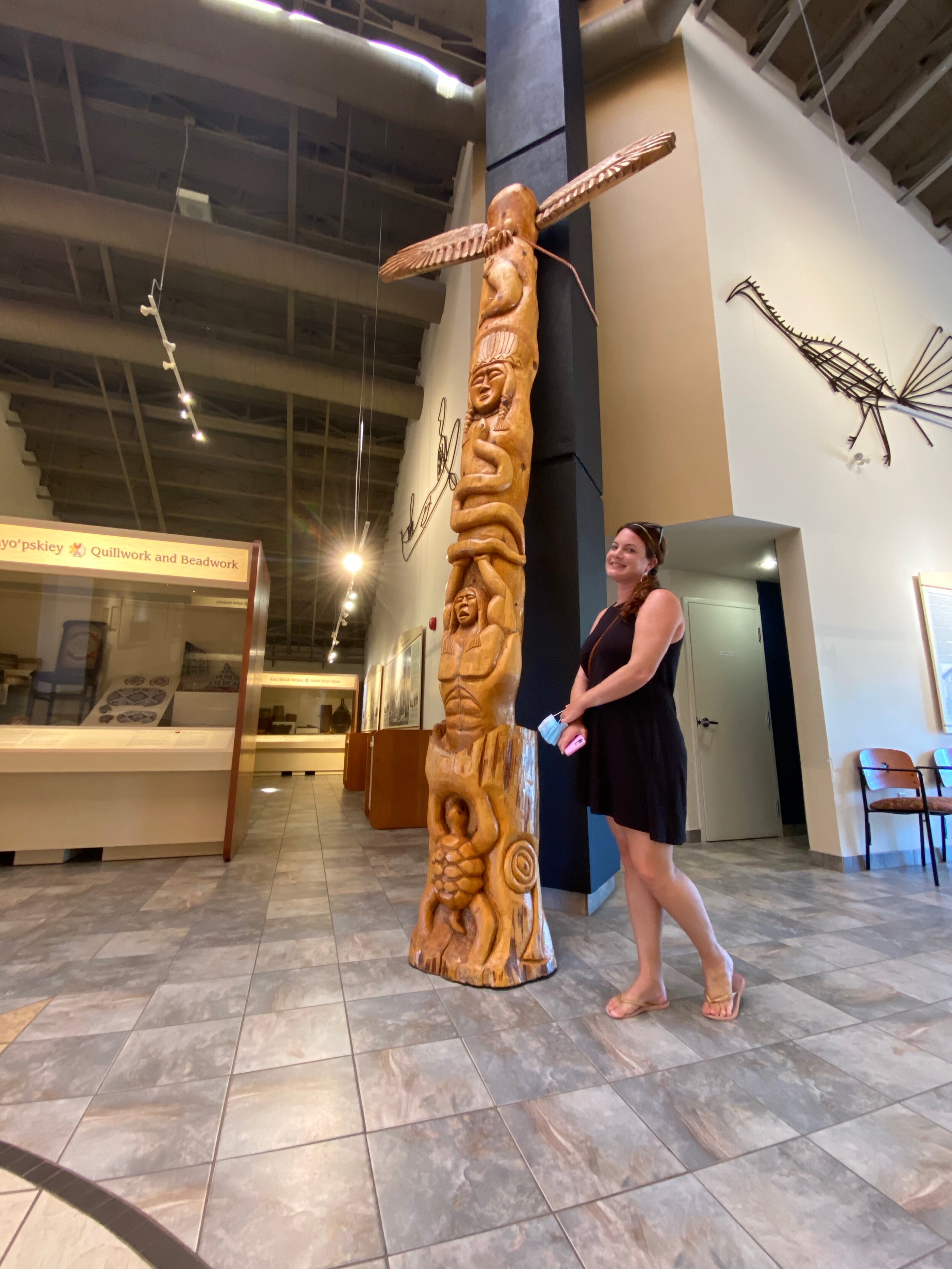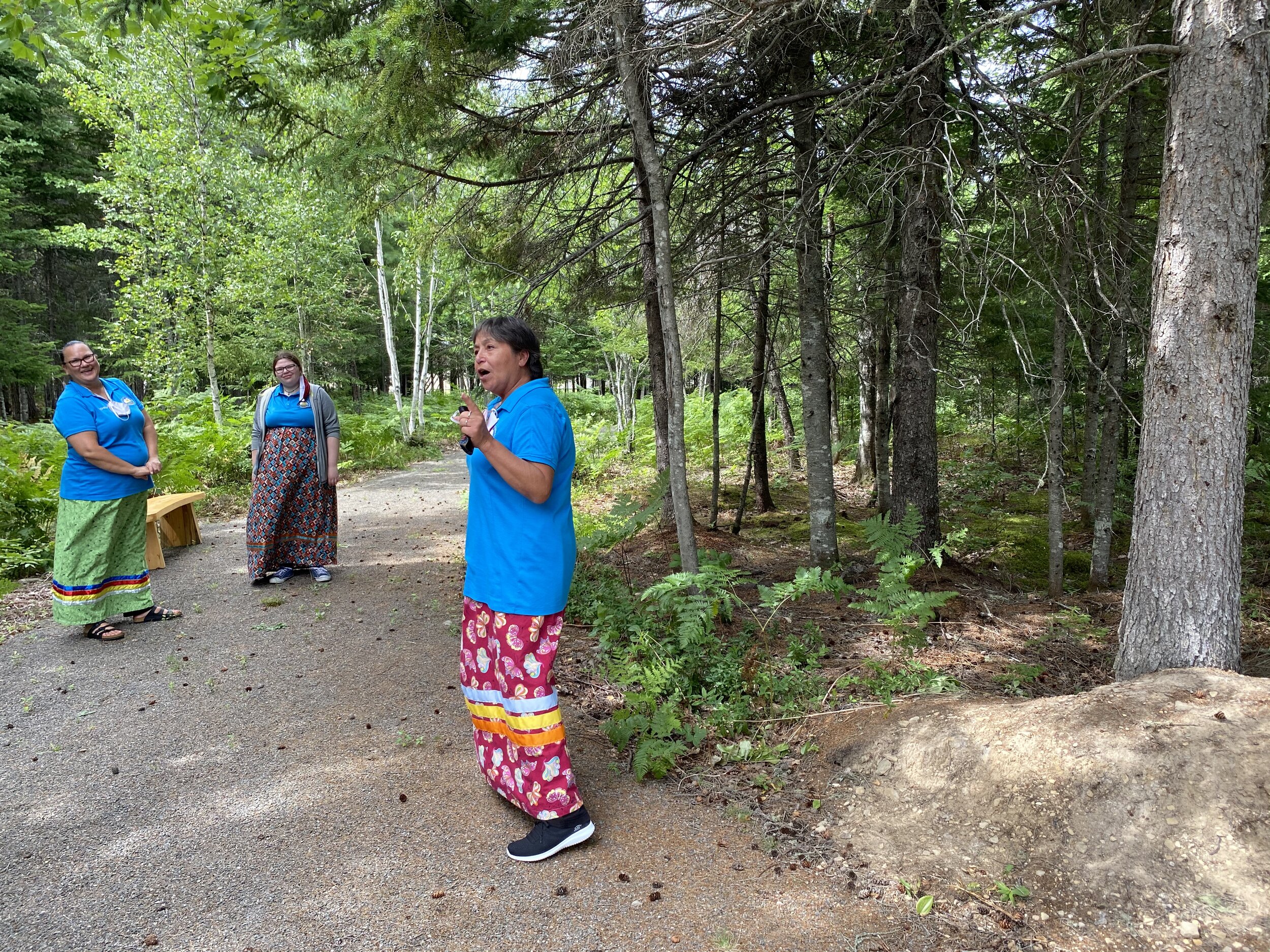Our “Escape from Home”: Discovering Indigineous Tourism in the Maritimes
Admiring the statue of Glooscap at Millbrook Cultural & Heritage Centre
As we write this we’ve just wrapped up the most incredible four days visiting Indigenous Tourism locations throughout Nova Scotia and New Brunswick with Destination Indigenous. Like most people from the Maritime Provinces we frequently drove through and past First Nations communities, yet we were both unaware of the amazing cultural experiences we were missing out on. We spent four days meeting absolutely incredible people who told us stories of the past and present, performed songs and danced for us, we tried delicious food, learned about the history of the Mi’kmaq people throughout Nova Scotia, New Brunswick and other provinces, and maybe most importantly left with more knowledge and respect of Indigenous Communities in Canada.
Darrell and Aiden performing Mi’kmaq music.
Our journey started on Cape Breton Island in Northern Nova Scotia. Our first stop was Kluskap Ridge RV and Campground. As the name suggests, at Kluscap they have serviced campsites, RV sites and cabins. Normally they would also have Teepees and glamping tents which we were told are extremely popular (so book early). We were given a tour of the property by co-owners Darrell Bernard and Aiden Christmas. The property itself is about 100 acres of which they use about 12 for the campsites (they also have plans to expand), you’ll also find many hiking trails, a pool and a playground. After our tour Darrell and Aiden played a couple of songs for us on drum and vocals and recounted Mi’kmaq stories which have been passed down for generations (one of how Glooscap obtained the game of Lacrosse). If you’re camping here expect some fun evenings of campfires, bread making (over the fire), song and dance and stories.
Making bread over a fire at Goat Island.
One of the stops at Goat Island.
About an hour drive from Kluskap you’ll find the community of Eskasoni which happens to be the largest Mi’kmaq community in the world. We visited Goat Island to do a tour called Eskasoni Cultural Journeys. Our tour guide Matthew Patles took us through the trail on a golf cart (you also have the option to walk but obviously it takes a bit longer). The trail has six stops at interpretive sites or villages, each with a different focus of Indigenous life, culture and history. You’ll find an interpreter at each site, all with a different expertise. We learned about weapons and tools and materials - how they were made and developed over time. The second stop was about Mi’kmaq dances as well as natural medicines, and there’s even some group participation as you learn steps to one of the dances. We then baked bread over a campfire (and of course got to eat it). The next stop also involved participation as we learned about basket weaving where we got to make our own bookmarks using the basic premises of basket weaving. The last couple of stops involved learning about hunting and fishing techniques followed by a smudging ceremony on the very last stop. We learned so much here and really enjoyed all the participation that was involved.
Later that day we drove to Millbrook, just outside of Truro where we stayed the night at Hampton Inn and Suites by Hilton. Be sure to check out the Mi’kmaq art on display throughout the hotel.
One of the exhibits at Millbrook Cultural & Heritage Centre
Aboriginal art at Millbrook Cultural & Heritage Centre
The next day we started things off at Millbrook Cultural & Heritage Centre, just down the road from the hotel. It’s sad to say, like so many people we had driven by here many times but this was our first visit. We were greeted by Operations Supervisor Heather Stevens and given a tour by our guide Garrett. You’ll first sit down to a video about the Mi’kmaq, explaining some important history, starting in ancient times, making its way through the arrival of the Europeans and the effect this had on the Mi’kmaq people throughout the region, and eventually ending with more recent times, and lasts about 20 minutes. Garrett then took us on a tour through the centre where we discussed some of the 13,500 years of history of the Mi’kmaq in the region. One really interesting thing for us was that we were able to get further in depth with things we learned at previous locations we visited. Garrett explained different aspects of weapons and tools and their evolution. We learned about Aboriginal artwork from quillwork and beadwork to basket weaving. One of the most famous features of the centre is just outside and is a huge 40 foot Glooscap statue.
The tour here took about two hours and afterwards we hopped in the car and drove about 3.5 hours to the middle of New Brunswick to an area called Red Bank, close to the city of Miramichi. We stayed the night in a gorgeous log building called Red Bank Lodge. The rooms are quite comfortable with cozy beds, private bathrooms and a fridge.
Red Bank Lodge
After waking up the next morning we took the five minute walk next door to Metepenagiag Heritage Park where we were greeted by General Manager Patricia Dunnett. She took us on a tour of the centre where we discussed not only the history of the Mi’kmaq in the region, but also the various Archeological sites in the area, the two most important being the Oxbow and Augustine Sites. The findings in these two sites have allowed researchers to learn so much about the history of Aboriginals in the area dating back thousands of years.
Cooking at Metepenagiag Heritage Park
After the tour we ventured outdoors where a fire was already burning. Our meal consisting of moose meat meatballs, fiddleheads and tea was already beginning to cook. Then the real fun began! Neither of us have ever made bread before, and definitely not like this. Patricia Instructed us, step-by-step on how to make this traditional bread called Lu’sknikn - from mixing to then burying it in the hot sand and ash. After about 25 minutes we dug it out using a rake, wiped it off and ate it. The entire meal was absolutely delicious and was one of the highlights of our multi-day experience!
Our Tour guides at Elsipogtog Mi’kmaq Cultural Centre
After leaving, we drove about 1.5 hours to Elsipogtog Mi’kmaq Cultural Centre where we were met by guide Anna-Marie Weir as well four other centre members who took us on a tour. The experience starts with a traditional greeting, a smudging ceremony. We were then guided along the outdoor heritage path tour where we learned about traditions, medicines and the Mi’kmaq way of life. They’re currently in the process of building a traditional long house as well as a sweat lodge. One particularly interesting part was learning about the history and workings of the sweat lodge, its historical significance and how it’s used today. The final part of the Heritage Path Tour involves a 30 minute Q&A where participants are encouraged to ask anything of the guides. This part was particularly unique to this experience and allows the interpreters and participants to get to know one another, it’s very beneficial to not only ask any remaining questions about the tour but also about life as a Mi’kmaq and Aboriginal. This being our very last stop it held an extra special significance.
This is without a doubt an experience we will never, ever forget. The two of us learned a lot in our “Escape from Home”! We had no idea that Indigenous communities had so much to offer in terms of fun, educational, and cultural activities. From learning about the history of Aboriginals in Canada, to cooking and eating fantastic food, meeting the most amazing people, these experiences offer something for every age and background. We’d encourage everyone to “Escape from Home” themselves and participate in some of these amazing cultural activities, you certainly won’t regret it!
What our experience on YouTube:
*This post is in partnership with the Indigenous Tourism Association of Canada.









